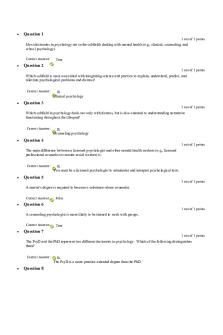Quiz 2 eco dev - quiz number 2 in finals PDF

| Title | Quiz 2 eco dev - quiz number 2 in finals |
|---|---|
| Course | Economic Development |
| Institution | Don Honorio Ventura Technological State University |
| Pages | 3 |
| File Size | 61.2 KB |
| File Type | |
| Total Downloads | 155 |
| Total Views | 181 |
Summary
Historically, low rate of population growth were maintained because of a. low fertility rates. b. high mortality rates . c. migration out of developing countries. d. government restrictions on the number of children families can have. If the birth rate is 6% and the death rate is 2%, the natural rat...
Description
.
1. Historically, low rate of population growth were maintained because of a. low fertility rates. b. high mortality rates c. migration out of developing countries. d. government restrictions on the number of children families can have. 2.
3
If the birth rate is 6% and the death rate is 2%, the natural rate of population increase is a. 0 .3% b. 3.0% c. 4.0% D . 8.0% Autarky refers to a country a. with an authoritarian government b. which is self sufficient, and is a closed economy c. which has free trade with the rest of the world d. none of the above
4. .Peasant farmers in LDCs are generally observed to a. respond appropriately to changes in price incentives b. use available resources efficiently C. both a and b d, . Neither a nor b 5. Which of the following is a direct implication of the view that childbearing is an economic decision? a. People will not have additional children unless they can earn a profit from doing so. b. Social factors have no effect on childbearing decisions. c. Compulsory education will increase fertility by raising each child's prospective earnings. d. Fertility should fall with improved opportunities for women to work in jobs outside the home. 6. Which of the following statements about rural and agricultural development is true? a. Rural development is the same as agricultural development. b. The agrarian community requires a full range of services such as schools, merchants, banks, and so on. c. Household nonfarm income is uncorrelated to farm productivity and household incomes in Kenya. d. China's rural population receives little income from nonfarm income. 7. A period of rapid population growth between a preindustrial, stable population characterized by high birth and death rates and a later, modern, stable population marked by low fertility and mortality is known as a. demographic transition.
b. population maturity. c. demobilizing population. d. birth-death transformation 8. The extraction of iron ore has increased on account of increased demand for steel. The above is an example of a. Forward linkages, b. Backward linkages c. Backward and forward linkages, d. None of the above 9. Which of the following is not true about agriculture's role in economic development a. Provides labor for non-agricultural sector, b. Provides a market for non-agricultural commodities, c. Source of industrial raw materials, d. None of the above 10.In the Harrod-Domar model, where traditional agriculture sector t is assumed that the elasticity of substitution between capital and labor is a. Infinite, b. One, c. Between zero and one, d. Zero 11. According to Malthus, the fixed factor of production is a. Labor, b. Capital, c.Land, d. Entrepreneurship 12..Suppose migrants are risks averse, then in the Harris-Todaro model, in equilibrium, the expected urban wages will be _________ the rural wage rate a. Greater than b. Equal to, c. Less than, d. None of the above 13.The dependency ratio is the ratio of a. children to adults in the population b. unemployed to employed workers in the labor force c. foreign aid to total GNP d. non-working age group population to working age population
14,Which of the following would not be considered as an example of industrialization a.Increase in literacy b. Replacement of human with mechanical skills c. Improved economic organization d. Improved extraction and working of raw materials
15 As migration takes place the per capita income of the workers a. At first rises,then falls, b. At first falls,then rises, c. Falls continuously, d. Rises continuously...
Similar Free PDFs

Euthenics 2 QUIZ- Finals
- 13 Pages

Euthenics 2 QUIZ- Finals
- 13 Pages

Euthenics 2 QUIZ Finals
- 13 Pages

Quiz-2 - Quiz 2
- 10 Pages

Quiz 2 - Quiz 2
- 6 Pages

Quiz 2 - Quiz 2
- 2 Pages

AS-101-Quiz2 - Quiz number 2
- 4 Pages

Quiz 2 - Online quiz in week 11
- 6 Pages

Quiz 2 - quiz
- 7 Pages

Online-Quiz-2 - quiz
- 4 Pages

IFSM QUIZ 2 - QUIZ
- 6 Pages

Quiz #2 - quiz
- 4 Pages

QUIZ 2 - Weekly Quiz
- 2 Pages

Week 2 Quiz - quiz
- 3 Pages

Quiz Pract 2 - quiz
- 2 Pages
Popular Institutions
- Tinajero National High School - Annex
- Politeknik Caltex Riau
- Yokohama City University
- SGT University
- University of Al-Qadisiyah
- Divine Word College of Vigan
- Techniek College Rotterdam
- Universidade de Santiago
- Universiti Teknologi MARA Cawangan Johor Kampus Pasir Gudang
- Poltekkes Kemenkes Yogyakarta
- Baguio City National High School
- Colegio san marcos
- preparatoria uno
- Centro de Bachillerato Tecnológico Industrial y de Servicios No. 107
- Dalian Maritime University
- Quang Trung Secondary School
- Colegio Tecnológico en Informática
- Corporación Regional de Educación Superior
- Grupo CEDVA
- Dar Al Uloom University
- Centro de Estudios Preuniversitarios de la Universidad Nacional de Ingeniería
- 上智大学
- Aakash International School, Nuna Majara
- San Felipe Neri Catholic School
- Kang Chiao International School - New Taipei City
- Misamis Occidental National High School
- Institución Educativa Escuela Normal Juan Ladrilleros
- Kolehiyo ng Pantukan
- Batanes State College
- Instituto Continental
- Sekolah Menengah Kejuruan Kesehatan Kaltara (Tarakan)
- Colegio de La Inmaculada Concepcion - Cebu
